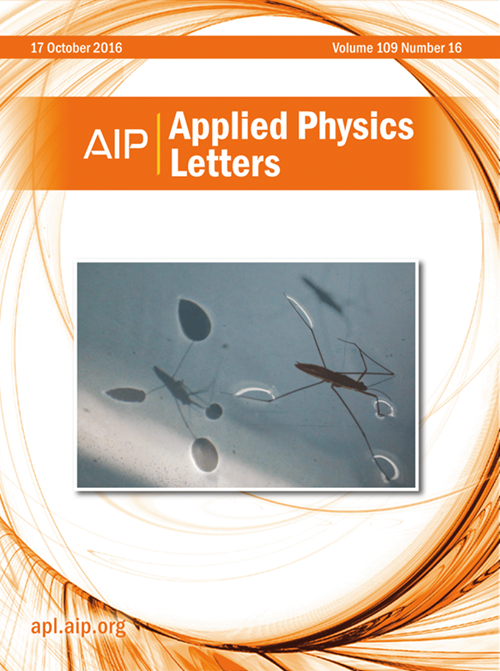Two-dimensional WTe2/Cr3Te4 heterostructures with high current-induced magnetization switching ratio
IF 3.5
2区 物理与天体物理
Q2 PHYSICS, APPLIED
引用次数: 0
Abstract
Two-dimensional (2D) magnetic materials have emerged as a promising platform for spintronic devices due to their ability to form van der Waals heterostructures with high-quality interfaces, circumventing the lattice-matching constraints of conventional materials. However, the relatively low switching efficiency (<60%) in spin–orbit torque (SOT) systems has limited the development of low-power spin devices based on 2D heterostructures. In this study, we synthesize 2D quasi-layered Cr3Te4 ferromagnets with strong perpendicular magnetic anisotropy via chemical vapor deposition method and investigate the SOT effect in WTe2/Cr3Te4 heterostructure through harmonic Hall measurements and current-induced magnetization switching. The heterostructure demonstrates a substantial damping-like effective field, reaching 800 Oe per 106 A cm−2 for spin-up and −480 Oe per 106 A cm−2 for spin-down configurations. Remarkably, current-induced magnetization reversal measurement reveals an unprecedented switching ratio of ∼90% with a low critical current density of 1.85 × 106 A cm−2, surpassing previously reported values in other 2D heterostructures. These findings not only deepen our understanding of efficient SOT switching mechanisms but also provide a critical step toward the realization of next-generation low-power spintronic devices.具有高电流感应磁化开关比的二维WTe2/Cr3Te4异质结构
二维(2D)磁性材料已经成为自旋电子器件的一个有前途的平台,因为它们能够形成具有高质量界面的范德华异质结构,绕过了传统材料的晶格匹配限制。然而,自旋-轨道转矩(SOT)系统相对较低的开关效率(<60%)限制了基于二维异质结构的低功率自旋器件的发展。本研究采用化学气相沉积法合成了具有强垂直磁各向异性的二维准层状Cr3Te4铁磁体,并通过谐波霍尔测量和电流感应磁化开关研究了WTe2/Cr3Te4异质结构中的SOT效应。异质结构表现出实质性的类似阻尼的有效场,自旋向上的有效场达到800 Oe / 106 a cm−2,自旋向下的有效场达到- 480 Oe / 106 a cm−2。值得注意的是,电流诱导磁化反转测量显示,在1.85 × 106 a cm−2的低临界电流密度下,前所未有的开关比为90%,超过了先前报道的其他2D异质结构的值。这些发现不仅加深了我们对高效SOT开关机制的理解,而且为实现下一代低功率自旋电子器件提供了关键的一步。
本文章由计算机程序翻译,如有差异,请以英文原文为准。
求助全文
约1分钟内获得全文
求助全文
来源期刊

Applied Physics Letters
物理-物理:应用
CiteScore
6.40
自引率
10.00%
发文量
1821
审稿时长
1.6 months
期刊介绍:
Applied Physics Letters (APL) features concise, up-to-date reports on significant new findings in applied physics. Emphasizing rapid dissemination of key data and new physical insights, APL offers prompt publication of new experimental and theoretical papers reporting applications of physics phenomena to all branches of science, engineering, and modern technology.
In addition to regular articles, the journal also publishes invited Fast Track, Perspectives, and in-depth Editorials which report on cutting-edge areas in applied physics.
APL Perspectives are forward-looking invited letters which highlight recent developments or discoveries. Emphasis is placed on very recent developments, potentially disruptive technologies, open questions and possible solutions. They also include a mini-roadmap detailing where the community should direct efforts in order for the phenomena to be viable for application and the challenges associated with meeting that performance threshold. Perspectives are characterized by personal viewpoints and opinions of recognized experts in the field.
Fast Track articles are invited original research articles that report results that are particularly novel and important or provide a significant advancement in an emerging field. Because of the urgency and scientific importance of the work, the peer review process is accelerated. If, during the review process, it becomes apparent that the paper does not meet the Fast Track criterion, it is returned to a normal track.
 求助内容:
求助内容: 应助结果提醒方式:
应助结果提醒方式:


